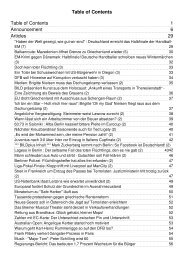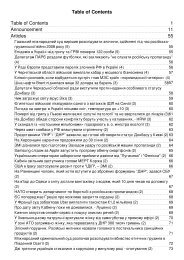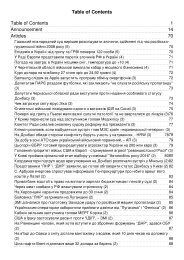- Page 1 and 2: Articles 377 articles, 2016-01-28 0
- Page 3 and 4: evenue projections of $225.63 milli
- Page 5 and 6: hook. Keeping in mind that so far,
- Page 7 and 8: satellite speakers. That means you
- Page 9 and 10: point to Apple returning to a 4in s
- Page 11 and 12: While ARM processors don't lack for
- Page 13 and 14: 8 The real reason Microsoft open so
- Page 15 and 16: Microsoft would rather keep Verizon
- Page 17 and 18: own area improves security too. The
- Page 19 and 20: Surface lineup has been showing sig
- Page 21 and 22: utton with TouchID. Looking at the
- Page 23: memory kit comes in with CL16 18-18
- Page 27 and 28: Then on the other side we have peop
- Page 29 and 30: off even more precious minutes. Ens
- Page 31 and 32: apps. This feature replaces the pre
- Page 33 and 34: XLN and Ze - have given the nod, al
- Page 35 and 36: of the Redmond effort, and came wit
- Page 37 and 38: Cognizant said in a statement on th
- Page 39 and 40: 2016-01-27 21:28:28 Andy Orin when
- Page 41 and 42: including its rumoured release date
- Page 43 and 44: There's also a day and night system
- Page 45 and 46: the Rome is also available in black
- Page 47 and 48: In general processing performance t
- Page 49 and 50: itself doesn't make a huge differen
- Page 51 and 52: deliveries via autonomous vehicles.
- Page 53 and 54: In addition to the restructuring, a
- Page 55 and 56: Articles are optimized for both iPh
- Page 57 and 58: Intelligence Laboratory (now the Co
- Page 59 and 60: 30 After lackluster Apple report, a
- Page 61 and 62: Nvidia. With GPUOpen, AMD is giving
- Page 63 and 64: Juniper. The telcos have signed ont
- Page 65 and 66: traditional and non-traditional" su
- Page 67 and 68: 34 Das Keyboard Division Zero Deliv
- Page 69 and 70: Skylake processors, as well as mobi
- Page 71 and 72: The chip-layer firmware technology
- Page 73 and 74: Overall, big data can end up perpet
- Page 75 and 76:
The number of shopping days until N
- Page 77 and 78:
39 Microsoft launches new OneDrive
- Page 79 and 80:
OneDrive for Business API. It allow
- Page 81 and 82:
41 Kaspersky Lab Adds New Layer to
- Page 83 and 84:
6 Network: 2 x Gigabit Ethernet Oth
- Page 85 and 86:
data with business partners who dev
- Page 87 and 88:
It's the same technology that Micro
- Page 89 and 90:
The rich, premium and spacious cabi
- Page 91 and 92:
cases, the malicious user will be a
- Page 93 and 94:
47 AcerScan 620U AcerScan has an op
- Page 95 and 96:
good choice for home or office. It
- Page 97 and 98:
arms to read the pattern of indenta
- Page 99 and 100:
It’s a well-known fact that Cyan
- Page 101 and 102:
Mbps downstream and 0.5-1.0 Mbps up
- Page 103 and 104:
services that can finally be conver
- Page 105 and 106:
devices, including DVD video and au
- Page 107 and 108:
Interestingly, it also brings with
- Page 109 and 110:
Malwarebytes Anti-Ransomware has bl
- Page 111 and 112:
upgrade as soon as possible. 2 hour
- Page 113 and 114:
ecoming very important not only for
- Page 115 and 116:
MSI also had an interesting AIO cal
- Page 117 and 118:
GIGABYTE Server is trying to push m
- Page 119 and 120:
noticeably (sub-1%) reduce performa
- Page 121 and 122:
margins dropped sharply. At some po
- Page 123 and 124:
comes with two Thunderbolt 2 ports.
- Page 125 and 126:
flash storage, he said. "We sell it
- Page 127 and 128:
support its peak performance number
- Page 129 and 130:
drives under a heatsink and provide
- Page 131 and 132:
Both the LIVA One and the SF100 can
- Page 133 and 134:
moving an enterprise to a new deskt
- Page 135 and 136:
developers and business looking to
- Page 137 and 138:
like no other entertainment industr
- Page 139 and 140:
system on its own, or does it have
- Page 141 and 142:
Manager probably have been mostly a
- Page 143 and 144:
was outdated, outmoded and absolute
- Page 145 and 146:
game or for content, what is the ba
- Page 147 and 148:
CES along with a host of updates fo
- Page 149 and 150:
With two 5GHz 4x4 radios, each band
- Page 151 and 152:
defining key to the system. IT will
- Page 153 and 154:
To support 3D TLC NAND, Silicon Mot
- Page 155 and 156:
68 Hate your cable company? Superfa
- Page 157 and 158:
70 app. Plagued by Chrome crashes o
- Page 159 and 160:
71 Not recycling is more immoral th
- Page 161 and 162:
obvious: arousal. But also for bore
- Page 163 and 164:
73 Apple's Tim Cook speaks: 6 juicy
- Page 165 and 166:
way to generate money. "Because our
- Page 167 and 168:
work? Greg Street discusses the new
- Page 169 and 170:
Heroku Private Spaces are runtime e
- Page 171 and 172:
77 VMware CIO Occupies Hot Seat Bet
- Page 173 and 174:
But it is not an implementer of Ope
- Page 175 and 176:
to earn your place at the table. "
- Page 177 and 178:
insanely more efficient than anythi
- Page 179 and 180:
Much like the Galaxy S6 before it,
- Page 181 and 182:
similar to the 3D Touch on the iPho
- Page 183 and 184:
cable. We'll assume that the Galaxy
- Page 185 and 186:
listed in the Chrome store, it had
- Page 187 and 188:
In addition, Ubuntu users will be a
- Page 189 and 190:
average four and a half times a day
- Page 191 and 192:
experience is typically the same, a
- Page 193 and 194:
the networking giant's software-def
- Page 195 and 196:
and the combination of increased ap
- Page 197 and 198:
a plant-watering service at his apa
- Page 199 and 200:
figure mark in seven markets for th
- Page 201 and 202:
professional services, healthcare a
- Page 203 and 204:
Kofax Onboarding Agility is a smart
- Page 205 and 206:
Sesto, president of Project6 Design
- Page 207 and 208:
are designed to handle troubles on
- Page 209 and 210:
the country to buy products from Ch
- Page 211 and 212:
stove, then finish in the oven or b
- Page 213 and 214:
98 The Best Android Apps to Make Dr
- Page 215 and 216:
102 All the Ways Credit Card Compan
- Page 217 and 218:
security companies. CSIT has one of
- Page 219 and 220:
market has peaked. 2016-01-27 21:29
- Page 221 and 222:
A growing number of businesses are
- Page 223 and 224:
to be a collaborative leader who ca
- Page 225 and 226:
in place. Just last week we deliver
- Page 227 and 228:
750 Ti models. Besides the Thunderb
- Page 229 and 230:
Aul's post today also reiterates th
- Page 231 and 232:
We examine some of the key trends
- Page 233 and 234:
fetch, improved shader efficiency,
- Page 235 and 236:
Bluetooth technology, and boast a 1
- Page 237 and 238:
deny) this but for £25, they look
- Page 239 and 240:
119 How to get your information ove
- Page 241 and 242:
2016-01-27 15:38:00 By Colin Barker
- Page 243 and 244:
etaining the variety that hardened
- Page 245 and 246:
iometrics on smartphones and bankin
- Page 247 and 248:
He noted that USAA , a US bank whic
- Page 249 and 250:
fintech market, he said there was t
- Page 251 and 252:
39 cents a share, on revenue of $7
- Page 253 and 254:
The iPhone accounted for $51 billio
- Page 255 and 256:
sides of the convertible. For perfo
- Page 257 and 258:
Apple's financials for Q1 16 are ou
- Page 259 and 260:
the connected world, announced Load
- Page 261 and 262:
Newswire 130 VoltDB adds geospatial
- Page 263 and 264:
initiatives and offer advertisers t
- Page 265 and 266:
European operations, served as pres
- Page 267 and 268:
improve the app and app content dis
- Page 269 and 270:
network via Web or email communicat
- Page 271 and 272:
embracing the technology. (Related:
- Page 273 and 274:
and promote it in more places than
- Page 275 and 276:
way to win today is to recognize,
- Page 277 and 278:
like rocket science, admittedly in
- Page 279 and 280:
invitation from Microsoft to be par
- Page 281 and 282:
name of its platform, says Mike Bau
- Page 283 and 284:
version 44, but software upgrades m
- Page 285 and 286:
placing one in a prime spot. Storie
- Page 287 and 288:
proof-of-concept exploit for a dese
- Page 289 and 290:
(The rental fees are also a huge bo
- Page 291 and 292:
compressing data and reducing your
- Page 293 and 294:
ability to use the most appropriate
- Page 295 and 296:
frequencies than 4G networks use. C
- Page 297 and 298:
systems vary widely in this regard,
- Page 299 and 300:
them to stay up there, and they wou
- Page 301 and 302:
148 The next generation of storage
- Page 303 and 304:
implementation may only be appropri
- Page 305 and 306:
devices. The role has been in high
- Page 307 and 308:
make sure it's bug-free. Job openin
- Page 309 and 310:
Revenue from Mac sales was about $6
- Page 311 and 312:
attack” on Israel’s Electricity
- Page 313 and 314:
hit and taken offline, but the coun
- Page 315 and 316:
usually provisioned with some rigou
- Page 317 and 318:
more. When through, if you’d like
- Page 319 and 320:
From a story in the New York Times
- Page 321 and 322:
Congress passed legislation that ga
- Page 323 and 324:
you once you told them to stop call
- Page 325 and 326:
company has already secured partner
- Page 327 and 328:
It also said the exposure can be pr
- Page 329 and 330:
Learning has to do with teaching ma
- Page 331 and 332:
The biggest user-centric improvemen
- Page 333 and 334:
ut that’s not all there’s to it
- Page 335 and 336:
Nevertheless, application and netwo
- Page 337 and 338:
For Herzog - perhaps harking back t
- Page 339 and 340:
comedian : "It can write jokes, and
- Page 341 and 342:
trial has he had to stand? Did he a
- Page 343 and 344:
contract without penalty if speeds
- Page 345 and 346:
and Activision said in a statement.
- Page 347 and 348:
Google is offering $50 off its smar
- Page 349 and 350:
entirely of snacks.” Enthused by
- Page 351 and 352:
what you get—a 5.7-inch WQHD AMOL
- Page 353 and 354:
Rear USB ports None Total storage 1
- Page 355 and 356:
IT security workers command a wage
- Page 357 and 358:
The Home Office declined to comment
- Page 359 and 360:
The winners will be announced on 28
- Page 361 and 362:
created. SHAREit is preloaded on Le
- Page 363 and 364:
mention the ridiculous amount of st
- Page 365 and 366:
173 Flash video is 'on life support
- Page 367 and 368:
got a group of upgrades on Wednesda
- Page 369 and 370:
participate in its beta program. If
- Page 371 and 372:
demand stores such as Amazon Instan
- Page 373 and 374:
copolymer called PLGA that we’re
- Page 375 and 376:
There are a growing number of appli
- Page 377 and 378:
oundaries of gaming and entertainme
- Page 379 and 380:
need good bandwidth for this to wor
- Page 381 and 382:
about the specifics of the project
- Page 383 and 384:
“By integrating the strengths of
- Page 385 and 386:
Nicolas Thibieroz reports for the G
- Page 387 and 388:
S. employed under the Optional Prac
- Page 389 and 390:
educe the value of stolen credit ca
- Page 391 and 392:
straightforward. Outlook 2010 patch
- Page 393 and 394:
Ah, but you probably know this alre
- Page 395 and 396:
strength of cyber capability, a tra
- Page 397 and 398:
a loop causing it to collapse. The
- Page 399 and 400:
Manta is the world’s first case e
- Page 401 and 402:
Materials: Fully steel plated exter
- Page 403 and 404:
months of living there, the neighbo
- Page 405 and 406:
oth, for long term, we offer them t
- Page 407 and 408:
support FinTech with legislation th
- Page 409 and 410:
sensing technologies such as GNSS (
- Page 411 and 412:
IT but also enables businesses to m
- Page 413 and 414:
cool. It also uses a complete modul
- Page 415 and 416:
MORE: All Motherboard Content MORE:
- Page 417 and 418:
taking ownership of - what the busi
- Page 419 and 420:
stores' and assuming bad news. " Th
- Page 421 and 422:
the delivery of some of the more co
- Page 423 and 424:
encourage some enterprises to opt i
- Page 425 and 426:
per year over three years, recogniz
- Page 427 and 428:
Even companies that agree with usin
- Page 429 and 430:
Vasquez of AES hopes the FASB revie
- Page 431 and 432:
200 No matter who wins in US vs. Mi
- Page 433 and 434:
201 Are iPhone sales set for a reco
- Page 435 and 436:
of digital business, and demanding
- Page 437 and 438:
The research will look in detail at
- Page 439 and 440:
amp up production in the summer ahe
- Page 441 and 442:
Also on the cards for future update
- Page 443 and 444:
Some scientists questioned whether
- Page 445 and 446:
found that most people are terrible
- Page 447 and 448:
Braithwaite, whose appointment was
- Page 449 and 450:
ad news for the UK is $15 billion a
- Page 451 and 452:
StarCade. The company said you can
- Page 453 and 454:
content developers a few tips and s
- Page 455 and 456:
Interim replacements are expected t
- Page 457 and 458:
214 Virtual Spaceships: First Look
- Page 459 and 460:
of you. To access an item, you look
- Page 461 and 462:
XP, so I don’t know what the stat
- Page 463 and 464:
launch tube. A few seconds later yo
- Page 465 and 466:
my test purposes, I only had access
- Page 467 and 468:
now, today's the day to buy it. To
- Page 469 and 470:
Thanks to its attachable marine-gra
- Page 471 and 472:
market... 2016-01-22 00:00:00 Kat O
- Page 473 and 474:
When HP Fortify studied smartwatche
- Page 475 and 476:
popular destination for the brains
- Page 477 and 478:
the debate over CTE, how and why it
- Page 479 and 480:
product. Silurian, which was a memb
- Page 481 and 482:
223 GCHQ VoIP software can be used
- Page 483 and 484:
Ireland (PLI) offline for two hours
- Page 485 and 486:
popular games, videos, social apps
- Page 487 and 488:
this sapphire screen is as hard as
- Page 489 and 490:
your system doesn’t mean that you
- Page 491 and 492:
different websites. If it is diffic
- Page 493 and 494:
designing a workable environment fo
- Page 495 and 496:
trick. Follow Rexly Peñaflorida II
- Page 497 and 498:
The bill would essentially legislat
- Page 499 and 500:
Facebook said it adapted tools that
- Page 501 and 502:
Verizon Chief Financial Officer Fra
- Page 503 and 504:
couple of years ago" means you're h
- Page 505 and 506:
or executable file we can largely a
- Page 507 and 508:
236 Big Auto Searches for Meaning B
- Page 509 and 510:
Uber and Lyft. Julia Steyn is vice
- Page 511 and 512:
After years, the wait for Intel-bas
- Page 513 and 514:
figures show. The research firm sai
- Page 515 and 516:
Harding added that the Telecoms Omb
- Page 517 and 518:
encrypt users' data cannot be blame
- Page 519 and 520:
The company also claimed that "the
- Page 521 and 522:
from West London. The boy was arres
- Page 523 and 524:
personal details leaked after TalkT
- Page 525 and 526:
very much detail, but yes, we have
- Page 527 and 528:
Little, said TalkTalk’s swift not
- Page 529 and 530:
ecommended that customers monitor t
- Page 531 and 532:
“Preventing all scam and nuisance
- Page 533 and 534:
transformation to higher value. In
- Page 535 and 536:
For strategy fans, the bundle will
- Page 537 and 538:
the end of the year, with server-ce
- Page 539 and 540:
Halfacree 243 US releases Iranian H
- Page 541 and 542:
infrastructure and defense companie
- Page 543 and 544:
vision of going wire-free, with new
- Page 545 and 546:
By offering a new access point for
- Page 547 and 548:
session is maintained over an insec
- Page 549 and 550:
detect errors, without the actual d
- Page 551 and 552:
Existing chips, hard disks and tape
- Page 553 and 554:
The company has been compiling a li
- Page 555 and 556:
250 BETT 2016: Education minister N
- Page 557 and 558:
workforce, bring in new skills and
- Page 559 and 560:
managing money and highly confident
- Page 561 and 562:
y testing out its HoloLens headset,
- Page 563 and 564:
254 AMD's Zen chips coming first to
- Page 565 and 566:
declining from $1.24 billion. 2016-
- Page 567 and 568:
256 Microsoft plans to donate $1 bi
- Page 569 and 570:
Microsoft's program to use TV white
- Page 571 and 572:
258 FBI Has Named Hacker allegedly
- Page 573 and 574:
http://applesecurity.serveuser.com/
- Page 575 and 576:
While the Commission hasn't opposed
- Page 577 and 578:
Processor Octa-core 2.0GHz Qualcomm
- Page 579 and 580:
which can connect serial and Ethern
- Page 581 and 582:
customers will be offered a one-yea
- Page 583 and 584:
currency as a whole. In any case, H
- Page 585 and 586:
up this weekend head to amazon.com/
- Page 587 and 588:
server at risk. "This information l
- Page 589 and 590:
to create custom chips for customer
- Page 591 and 592:
executable that the user double-cli
- Page 593 and 594:
AI systems to identify fraudsters b
- Page 595 and 596:
year, amid growing competition and
- Page 597 and 598:
270 ‘Consumers Oblivious of Manda
- Page 599 and 600:
advantage of the integration, but m
- Page 601 and 602:
one’s notifications as small but
- Page 603 and 604:
Waikato, New Zealand (http://www.cs
- Page 605 and 606:
novel, potentially useful, and even
- Page 607 and 608:
equired results in terms of reports
- Page 609 and 610:
delivery company Colis Privé. 2016
- Page 611 and 612:
The spectrum on offer is the same s
- Page 613 and 614:
power and temporary disk performanc
- Page 615 and 616:
order to maintain their relevance.
- Page 617 and 618:
277 Intex unveils most affordable 4
- Page 619 and 620:
mouse ball. Its advanced optical tr
- Page 621 and 622:
However, it also contained addition
- Page 623 and 624:
tasks? The social media tools are m
- Page 625 and 626:
- Auto-follow back feature included
- Page 627 and 628:
system to handle the deluge of docu
- Page 629 and 630:
282 How Small Businesses Can Benefi
- Page 631 and 632:
price of just Rs. 999/month”, add
- Page 633 and 634:
outcome. Hire Marketing Resources a
- Page 635 and 636:
powered gyroscope whirs to life. It
- Page 637 and 638:
ehaviour of users. The insights are
- Page 639 and 640:
Snapdragon 820. Qualcomm said it ha
- Page 641 and 642:
CRISPR Therapeutics is one of three
- Page 643 and 644:
Treating genetic eye disorders is a
- Page 645 and 646:
malicious code and execute it on yo
- Page 647 and 648:
Azure cloud platform as a supported
- Page 649 and 650:
imaging. The study is the first org
- Page 651 and 652:
whose brains are further developed.
- Page 653 and 654:
company has opened in Ireland. Anno
- Page 655 and 656:
“Demo Day is a platform for a che
- Page 657 and 658:
Apple has previously reported that
- Page 659 and 660:
294 The Dubious Promise of Bioenerg
- Page 661 and 662:
such facilities to greenhouse gas e
- Page 663 and 664:
295 Barracuda Introduces New Cloud
- Page 665 and 666:
eventually getting to a point where
- Page 667 and 668:
from Ford and from others? I think
- Page 669 and 670:
Le 3D Helmet and the LeMe Bluetooth
- Page 671 and 672:
eversed a congenital eye defect. Th
- Page 673 and 674:
placing human cells into an animal
- Page 675 and 676:
says Pablo Ross, a veterinarian and
- Page 677 and 678:
At a press conference at CES Tuesda
- Page 679 and 680:
add 25 gigawatts of new solar capac
- Page 681 and 682:
generation, where producers can tra
- Page 683 and 684:
302 How Drones May Avoid Collisions
- Page 685 and 686:
y nearly 2,000 pages of documents t
- Page 687 and 688:
Voodoo: Voodoo app will help Delhi
- Page 689 and 690:
Yang’s lab is improving on a basi
- Page 691 and 692:
the air makes it possible to store
- Page 693 and 694:
We need energy storage in the teraw
- Page 695 and 696:
uninterrupted. But the question is:
- Page 697 and 698:
FCC research report, a 4G connectio
- Page 699 and 700:
experience for each and every custo
- Page 701 and 702:
availability, they deliver exceptio
- Page 703 and 704:
ecognizes HDS’ commitment to scal
- Page 705 and 706:
That could be useful for companies
- Page 707 and 708:
streamed or imported in batches. Th
- Page 709 and 710:
grown. But Network bandwidth/data t
- Page 711 and 712:
locks. In general, commodity hardwa
- Page 713 and 714:
term. Log Analysis: Calculate the t
- Page 715 and 716:
makeover contest where one winner i
- Page 717 and 718:
eforehand, it gained new prominence
- Page 719 and 720:
users complete control over how it
- Page 721 and 722:
Called HPE Synergy, it combines sto
- Page 723 and 724:
what they've done is innovative," h
- Page 725 and 726:
e asked to do more than just keep t
- Page 727 and 728:
internally, and they've liked it, h
- Page 729 and 730:
explained. For example, "mainframe
- Page 731 and 732:
The best way to judge a smartphone
- Page 733 and 734:
to better low-light performance. As
- Page 735 and 736:
321 Installing NTOPNG — A Web-Bas
- Page 737 and 738:
# -e|-daemon # This parameter cause
- Page 739 and 740:
# (-m) numeric IPs 1 - Decode DNS r
- Page 741 and 742:
-interface 1 STEP 7: To see all ava
- Page 743 and 744:
elieve that software needs to be fu
- Page 745 and 746:
Demographics of the state of softwa
- Page 747 and 748:
discount coupons from over 100 top
- Page 749 and 750:
of accessibility, it will seek to h
- Page 751 and 752:
though, the excuse feels like a som
- Page 753 and 754:
The Xen patches released Thursday f
- Page 755 and 756:
direct increase in sales. Twitter d
- Page 757 and 758:
Then we previewed two significant t
- Page 759 and 760:
In order for white box to happen yo
- Page 761 and 762:
We’re finding rich, rich opportun
- Page 763 and 764:
As always happens in early markets,
- Page 765 and 766:
vice president at IDC. WD itself no
- Page 767 and 768:
WD said that Steve Milligan will co
- Page 769 and 770:
number of HDDs or SSDs: Steal marke
- Page 771 and 772:
of the other features AWS offers. C
- Page 773 and 774:
Jason Fischl is the company’s vic
- Page 775 and 776:
versatile tablet till date. Smoothl
- Page 777 and 778:
$mv SugarCE-Full-6.5.18 sugercrm $m
- Page 779 and 780:
335 BT Group may give OpenStack the
- Page 781 and 782:
OpenStack is "still a very complex,
- Page 783 and 784:
337 What Dell buying EMC means for
- Page 785 and 786:
(VMware customers’) underlying ha
- Page 787 and 788:
clouds using vSphere. and tools to
- Page 789 and 790:
339 Four questions about the Dell-E
- Page 791 and 792:
to reduce EMC's involvement too. He
- Page 793 and 794:
In addition, Dell needs EMC's sales
- Page 795 and 796:
correctly for each target operating
- Page 797 and 798:
understanding the huge flexibility
- Page 799 and 800:
Numerous tech companies have been f
- Page 801 and 802:
market with its acquisition of NuSp
- Page 803 and 804:
sold the Shasta assets to Ericsson
- Page 805 and 806:
few CPE opportunities with SDN and
- Page 807 and 808:
people keep buying iPhones and iPad
- Page 809 and 810:
massive install bases across severa
- Page 811 and 812:
You could say we’re stretching a
- Page 813 and 814:
344 Microsoft Edge Browser Replaces
- Page 815 and 816:
an image file in email or social ap
- Page 817 and 818:
It’s an exciting area with new de
- Page 819 and 820:
deployment to the cloud, both users
- Page 821 and 822:
on the processes and the skills ass
- Page 823 and 824:
flexibility, infinite elasticity an
- Page 825 and 826:
covers the subject of Software Qual
- Page 827 and 828:
• 2 years warranty The AirCard 78
- Page 829 and 830:
company source the surplus units di
- Page 831 and 832:
2015-07-31 09:29:41 Anuj Sharma 351
- Page 833 and 834:
Paragon Software Group, the technol
- Page 835 and 836:
friendly and can be attached to any
- Page 837 and 838:
in a wide range of use cases from s
- Page 839 and 840:
Using templated event binding, CanJ
- Page 841 and 842:
easy-to-use data binding features c
- Page 843 and 844:
Kejriwal, CEO and Co-Founder of Gam
- Page 845 and 846:
Exercise Mode records workouts with
- Page 847 and 848:
customizable watch faces, Caller ID
- Page 849 and 850:
offer will be available for the fir
- Page 851 and 852:
The AMD Radeon R9 Fury, with both l
- Page 853 and 854:
specialty dry ink station that enha
- Page 855 and 856:
With a 50.6-megapixel 35mm full-fra
- Page 857 and 858:
XC10 - INR 1,70,000 Canon also reve
- Page 859 and 860:
The Results Due to the deployments,
- Page 861 and 862:
Filing the FIR remotely irrespectiv
- Page 863 and 864:
leaving their rubber-mark on the tw
- Page 865 and 866:
4.4 and offers features a 7-Inch WS
- Page 867 and 868:
help them make better decisions and
- Page 869 and 870:
string of Arabic and English charac
- Page 871 and 872:
at Rs. 29,999.00 and 4GB memory 1 t
- Page 873 and 874:
techniques that can be employed to
- Page 875 and 876:
one of the first states in e-readin
- Page 877 and 878:
user search option not optimised, G
- Page 879 and 880:
371 Configuring Windows Deployment
- Page 881 and 882:
2015-03-24 11:27:26 Raj Kumar Maury
- Page 883 and 884:
Around 85 per cent of IT profession
- Page 885 and 886:
CPU: 2 x 2.6GHz E5-2690 v3 Xeon (12
- Page 887 and 888:
Transformer Pad TF103 tablet, Lenov
- Page 889 and 890:
376 Canon Powershot SX600 HS Camera
- Page 891 and 892:
377 Best Runner-Up SME Project: Cen
- Page 893 and 894:
growth of knowledge as every member











